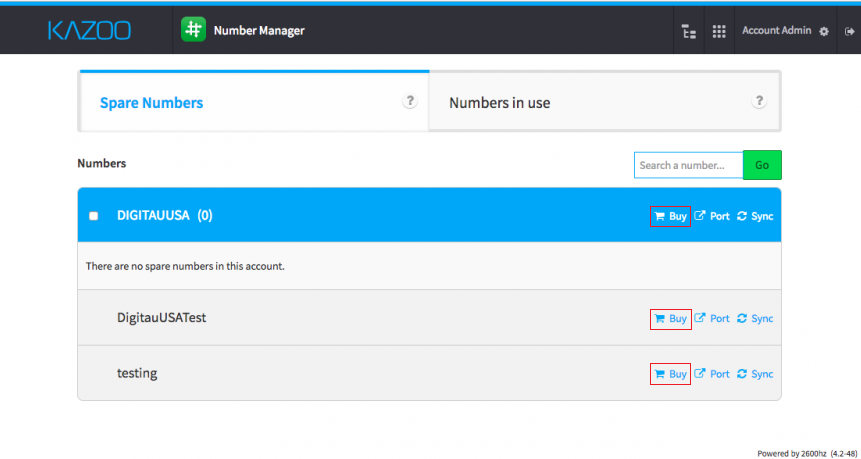-
Posts
76 -
Joined
Content Type
Profiles
Forums
Resource Library: Monster UI Apps for KAZOO
Events
Downloads
Posts posted by ...
-
-
This feature request was added to the roadmap (expected to get attention during Q4).
Issue tracker: UI-3384
-
-
Roger that, your complaint was reported to our backend team and a fix in the form of a system config flag to control this feature will come around soon (I didn't get a hard time line though).
-
Correct, this toggle only impacts the current account you are logged into.
-
I believe one way to disable such notifications would be to turn the threshold alerts off:
Control Center > Usage Charges > Add Credit > Threshold Alerts > toggle "Turn on Threshold Alerts" off
-
The Provisioner and Call Center apps are both paid apps.
That said, you do not inherently need to use 2600Hz's hosted platform to buy those apps; I encourage your to contact sales@2600hz.com for more information.
-
On 6/3/2018 at 10:45 AM, digitauusa said:
When I go to the number management, It does not show the + Add, I have attached a screenshot of the screen.
In order to add spare numbers to an account, you need to buy them.
To do so, just click the `Buy` button corresponding to the account to which you want to add spare numbers to, and pick the number type and area code.
Once that's done, the numbers will be listed as spare numbers under the account you chose when buying them.
-
16 hours ago, dvbrusselen said:
curl -X PUT \
https://api.company.be:8443/v2/accounts/XXXXXXXXXXXXXXXXXXXXXxxxx/queues
-H "X-Auth-Token: XXXXXXXXXXXXXXXXXXXXXXXXXXXXX" \
-H "Content-Type: application/json" \
-v \
-d '{
"data": {
"name": "{QUEUE_NAME}"
}
}'The endpoint your are trying to hit does not exist, you need to use `qubicle_queues` instead of simply `queues`, like so:
/v2/accounts/{ACCOUNT_ID}/qubicle_queuesHere is the documentation for this particular endpoint: https://docs.2600hz.com/qubicle/doc/crossbar/qubicle_queues/#create-a-queue
-
The issue here is that Sprint does not have test servers, which means we ourselves had to use real numbers/devices to develop the 2600Hz Mobile app. At first, Tower-Of-Power (TOP), which is the glue between Sprint's APIs and Kazoo, was configured to work with our sandbox environment for testing purposes, but when the app got out of the beta program and ready for production, TOP's sandbox data was erased so it could be used with our production environment.
In the end, I don't really know why the app is still available on sandbox, or how/why you had access to it, but it won't work as long as we don't have a secondary version of TOP deployed specifically for our sandbox environment.
-
Currently, it is not possible to achieve this result in Operator Console.
I created a ticket to acknowledge your feature request and keep track of it.
-
Hi,
Over the years, I have been building a Postman collection of Kazoo APIs that I use for testing purposes when building Monster applications.
It seems like people would be interested in such a collection, and because we would rather not have to work on a Developer app that would be inferior in every way, I just created a quick tutorial on how to import that collection and set up Postman to make it easy to use and automate authentication (specifically, storing the authentication token and reusing it for every request).
Keep in mind that this collection is extensive but not 100% complete and some PUT/POST endpoints are missing.
-
Hi @Tuly,
To define the name of a callfow, you will have to create a `name` property at the root level of your callfow object.
In your case, it would look like this:
{ "data": { "name": "Tuly's new callfow", "flow": { ... }, "numbers": [ "*1000" ], "patterns": [] } }
Also, unless you are updating an existing callfow, you do not have to add the `id` property, as it will be generated automatically upon creation of your callfow.



Monster-UI Translation
in General OS Kazoo Questions
Posted
Since the Callflows app is open source, you can check out the code repository which contains, among other things, the internationalization source of truth file (e.g. en-US):
https://github.com/2600hz/monster-ui-callflows/blob/master/i18n/en-US.json
To add a new language, you should: